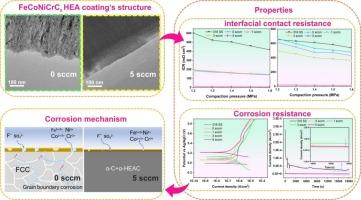Conductive passivation via carbon mediated defect control in FeCoNiCrCx high-entropy alloy coatings: breaking conductivity-corrosion trade-off for PEMFC bipolar plates
IF 6.9
2区 材料科学
Q2 CHEMISTRY, PHYSICAL
引用次数: 0
Abstract
Stainless steel bipolar plates (BPs) for proton exchange membrane fuel cells (PEMFC) face an inherent corrosion-conductivity conflict. Corrosion-resistant passivation layers, such as Cr2O3, induce unacceptable interfacial contact resistance (ICR) elevation. We resolve this conflict using high-power impulse magnetron sputtering (HiPIMS) to deposit FeCoNiCrCx coatings with carbon-mediated defect control, where acetylene flow regulation (0–5 sccm) triggers three synergistic effects: carbon-mediated amorphization eliminates grain boundaries to suppress ionic diffusion; in-situ carbide formation, primarily Cr3C2, consumes reactive metals and inhibits oxide nucleation; and sp2-carbon networks establish efficient electron-conduction pathways. The optimized 5 sccm coating delivers exceptional performance in simulated PEMFC cathode conditions: corrosion current plunges to 0.079 μA/cm2. Simultaneously, ICR is maintained at 7.9 mΩ cm2 under 1.4 MPa compaction, outperforming U.S. Department of Energy (DOE) 2025 targets. X-ray photoelectron spectroscopy (XPS) and transmission electron microscopy (TEM) analyses validate a carbon-dominated barrier layer exceeding 80 at.% carbides and amorphous carbon. This layer effectively replaces insulating oxides, ensuring post-polarization ICR stability. This work demonstrates conductive passivation as an effective materials strategy that breaks the persistent corrosion-conductivity trade-off in metallic BPs through carbon-mediated defect control

通过碳介导缺陷控制feconicrx高熵合金涂层的导电钝化:PEMFC双极板的断裂导电性-腐蚀权衡
用于质子交换膜燃料电池(PEMFC)的不锈钢双极板(bp)面临着固有的腐蚀与导电性冲突。耐腐蚀钝化层,如Cr2O3,诱导不可接受的界面接触电阻(ICR)升高。我们使用高功率脉冲磁控溅射(HiPIMS)沉积具有碳介导缺陷控制的feconicrx涂层,其中乙炔流量调节(0-5 sccm)触发三个协同效应:碳介导的非晶化消除了晶界,抑制了离子扩散;原位碳化物形成,主要是Cr3C2,消耗活性金属,抑制氧化物成核;sp2-碳网络建立了有效的电子传导途径。优化后的5 sccm涂层在模拟PEMFC阴极条件下具有优异的性能:腐蚀电流降至0.079 μA/cm2。同时,在1.4 MPa压实下,ICR保持在7.9 mΩ cm2,优于美国能源部2025年的目标。x射线光电子能谱(XPS)和透射电子显微镜(TEM)分析证实了碳主导的势垒层超过80 at。%碳化物和无定形碳。该层有效取代绝缘氧化物,确保极化后ICR的稳定性。这项工作证明了导电钝化是一种有效的材料策略,通过碳介导的缺陷控制打破了金属bp中持续腐蚀和导电性之间的权衡
本文章由计算机程序翻译,如有差异,请以英文原文为准。
求助全文
约1分钟内获得全文
求助全文
来源期刊

Applied Surface Science
工程技术-材料科学:膜
CiteScore
12.50
自引率
7.50%
发文量
3393
审稿时长
67 days
期刊介绍:
Applied Surface Science covers topics contributing to a better understanding of surfaces, interfaces, nanostructures and their applications. The journal is concerned with scientific research on the atomic and molecular level of material properties determined with specific surface analytical techniques and/or computational methods, as well as the processing of such structures.
 求助内容:
求助内容: 应助结果提醒方式:
应助结果提醒方式:


